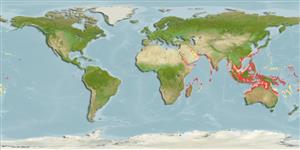Common names from other countries
>
Clupeiformes (Herrings) >
Dussumieriidae (Round herrings)
Etymology: Dussumieria: In honor of Dussumier, a collaborator of Cuvier, who sent him collections of fishes from the Indian Ocean (Ref. 45335).
More on author: Bleeker.
Environment: milieu / climate zone / depth range / distribution range
Ecologia
marinhas; intervalo de profundidade 0 - 50 m (Ref. 188). Subtropical; 31°N - 26°S, 32°E - 168°W (Ref. 188)
Indo-Pacific: Suez and western Indian Ocean (the Persian Gulf to Mombasa; possibly to Madagascar) to China, the Arafura Sea (Ref. 9819) and to about Tonga. Previous records of Dussumieria acuta from northeastern Indian Ocean would refer to this species (Ref. 5978).
Tamanho / Peso / Idade
Maturity: Lm ? range ? - ? cm
Max length : 20.0 cm SL macho/indeterminado; (Ref. 188)
Espinhos dorsais (total) : 0; Raios dorsais (total) : 16 - 18; Espinhos anais: 0; Raios anais : 14 - 18. Branchiostegal rays more (13 to 17) and no striae on posterior part of scales; pelvic fins more advanced; W-shaped pelvic scute; isthmus with tapering evenly forward; more anal fin rays.
Pelagic inshore (Ref. 68964). The habitat and biology are presumably similar to those of D. acuta from which this species was not distinguished in earlier studies. Marketed fresh, may be dried or salted (Ref. 5284).
Ciclo de vida ou comportamento de acasalamento
Maturities | Reprodução | Spawnings | Egg(s) | Fecundities | Larvas
Whitehead, P.J.P., 1985. FAO Species Catalogue. Vol. 7. Clupeoid fishes of the world (suborder Clupeoidei). An annotated and illustrated catalogue of the herrings, sardines, pilchards, sprats, shads, anchovies and wolf-herrings. FAO Fish. Synop. 125(7/1):1-303. Rome: FAO. (Ref. 188)
Status na Lista Vermelha da UICN (Ref. 130435)
CITES (Ref. 128078)
Not Evaluated
Ameaça para os humanos
Harmless
Uso pelos humanos
Pescarias: pouco comercial
Ferramentas
Relatórios especiais
Baixar XML
Fontes da internet
Estimates based on models
Preferred temperature (Ref.
115969): 25.4 - 29.1, mean 28.3 (based on 1238 cells).
Índice de diversidade filogenética (Ref.
82804): PD
50 = 0.7520 [Uniqueness, from 0.5 = low to 2.0 = high].
Bayesian length-weight: a=0.00776 (0.00485 - 0.01241), b=3.08 (2.94 - 3.22), in cm Total Length, based on LWR estimates for this species & (Sub)family-body (Ref.
93245).
Nível Trófico (Ref.
69278): 3.5 ±0.43 se; based on food items.
Resiliência (Ref.
120179): Elevada, tempo mínimo de duplicação da população menor que 15 meses (K=0.55).
Fishing Vulnerability (Ref.
59153): Low vulnerability (24 of 100).
Climate Vulnerability (Ref.
125649): Moderate to high vulnerability (49 of 100).
